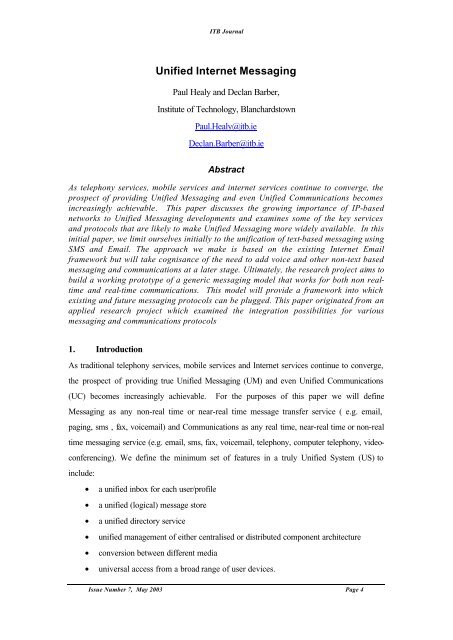ITB Journal-May-2003 - Institute of Technology Blanchardstown
ITB Journal-May-2003 - Institute of Technology Blanchardstown
ITB Journal-May-2003 - Institute of Technology Blanchardstown
Create successful ePaper yourself
Turn your PDF publications into a flip-book with our unique Google optimized e-Paper software.
<strong>ITB</strong> <strong>Journal</strong><br />
Unified Internet Messaging<br />
Paul Healy and Declan Barber,<br />
<strong>Institute</strong> <strong>of</strong> <strong>Technology</strong>, <strong>Blanchardstown</strong><br />
Paul.Healy@itb.ie<br />
Declan.Barber@itb.ie<br />
Abstract<br />
As telephony services, mobile services and internet services continue to converge, the<br />
prospect <strong>of</strong> providing Unified Messaging and even Unified Communications becomes<br />
increasingly achievable. This paper discusses the growing importance <strong>of</strong> IP-based<br />
networks to Unified Messaging developments and examines some <strong>of</strong> the key services<br />
and protocols that are likely to make Unified Messaging more widely available. In this<br />
initial paper, we limit ourselves initially to the unification <strong>of</strong> text-based messaging using<br />
SMS and Email. The approach we make is based on the existing Internet Email<br />
framework but will take cognisance <strong>of</strong> the need to add voice and other non-text based<br />
messaging and communications at a later stage. Ultimately, the research project aims to<br />
build a working prototype <strong>of</strong> a generic messaging model that works for both non realtime<br />
and real-time communications. This model will provide a framework into which<br />
existing and future messaging protocols can be plugged. This paper originated from an<br />
applied research project which examined the integration possibilities for various<br />
messaging and communications protocols<br />
1. Introduction<br />
As traditional telephony services, mobile services and Internet services continue to converge,<br />
the prospect <strong>of</strong> providing true Unified Messaging (UM) and even Unified Communications<br />
(UC) becomes increasingly achievable. For the purposes <strong>of</strong> this paper we will define<br />
Messaging as any non-real time or near-real time message transfer service ( e.g. email,<br />
paging, sms , fax, voicemail) and Communications as any real time, near-real time or non-real<br />
time messaging service (e.g. email, sms, fax, voicemail, telephony, computer telephony, videoconferencing).<br />
We define the minimum set <strong>of</strong> features in a truly Unified System (US) to<br />
include:<br />
• a unified inbox for each user/pr<strong>of</strong>ile<br />
• a unified (logical) message store<br />
• a unified directory service<br />
• unified management <strong>of</strong> either centralised or distributed component architecture<br />
• conversion between different media<br />
• universal access from a broad range <strong>of</strong> user devices.<br />
Issue Number 7, <strong>May</strong> <strong>2003</strong> Page 4
















